Electric cars are in the ascendancy. In the future, more and more new cars will be zero-emissions electric vehicles. The government’s aim is to encourage growing numbers of people to consider an electric car.
Researching an electric car requires you to understand new phrases and jargon, such as ‘EV’ being shorthand for electric vehicle. More and more electric cars are becoming available on the Motability Scheme, so in this article, Richard Aucock of Motoring Research gives a beginner’s guide to understanding electric car terminology. Time to electrify your knowledge of EVs.
What is an electric car?
An electric car has no petrol or diesel engine, or fuel tank. It is driven by an electric motor, powered by a high-capacity battery pack. EVs are ‘refuelled’ by plugging in and recharging the batteries.
How can I find an electric car on the Motability Scheme?
Motability Scheme customers can now choose to pick from pure electric cars, by ticking the ‘Electric’ box under ‘Fuel Type’ in the Car Search tool.
What is electric car range?
The range of an electric car is how far it will travel, on average, on fully-charged batteries. Early electric cars had a limited range, but modern ones go much further – some will drive more than 300 miles between charges.
Why is range important?
The range of an electric car is important because charging the batteries takes longer than filling a car’s fuel tank. If you simply plug an EV into the mains, charging takes hours. A home charging point is faster, while public ‘fast’ or ‘rapid’ chargers are faster still.
What is a home charging point?
A home charging point is a dedicated electric car charger. It is installed by power companies, who wire it into your electricity supply. This means they can supply more charge than a regular plug socket – they often charge electric cars almost twice as quickly.
Understanding kW and kWh
Regular cars have different-sized engines: a 1.0-litre or a 1.6-litre, for example. They are rated in terms of horsepower (hp) or its European equivalent, PS. However, for electric cars, kilowatts (kW) is the all-important figure you need to understand. A kilowatt is 1,000 watts.
kW: The output of an electric car motor – its ‘power’. The output of an average kettle, for example, is 2kW. A higher figure indicates a more powerful model: a small electric car will produce 60kW; larger ones will produce upwards of 100kW.
kWh: The output of an electric car battery. It stands for kilowatt hours, and is the standard term used by electricity companies to price up power (they call 1 kWh a ‘unit’ of electricity). A small electric car might have a 17kWh battery; larger models generally start from 40kWh. The higher the kWh rating of the battery, the greater the car’s range will be.
What is range anxiety?
Range anxiety is the fear of running out of charge before you reach the end of your journey. It used to be a big issue for electric car drivers, because ranges were limited. For those new to EVs, it is also a big hurdle to overcome. However, the ever-extending range of modern electric cars means range anxiety is becoming less of an issue. Many owners of the latest models simply do not consider it a concern.
Charging an electric car
For some, the appeal of an electric car is the ability to charge at home. They never have to visit a filling station again – and each morning they have a full battery with hundreds of miles of range. Before you take delivery of a new electric car, your dealer will help arrange the installation of a home charging point.
Electric car plugs
One of the most frustrating aspects of electric cars is the different types of charging plugs they use. There is no one single type, but three different plugs, as well as the standard UK three-pin type. Here are the most common types, and the car brands that use them.
Type 1 – An early type of plug used by Nissan, Mitsubishi and Vauxhall
Type 2 – Fast becoming the most popular type of plug used by most European brands
CHAdeMO – A rapid charging plug used by Nissan and Mitsubishi
CCS – The standard type of rapid charging plug used by European brands
Why do I need to know about electric car plugs?
You need to know what sort of plug your electric car uses because it will impact your ability to use public chargers. Different chargers (and charge networks) favour different plugs, although many newer units have multiple plug types.
What is a public charger?
Public chargers are often located at motorway service stations, in car parks, or at the roadside. They are ‘electric car filling stations’ that allow owners to charge their batteries away from their home. A word of warning: there are lots of different charging networks, and in order to use a public charger, you need to have a subscription. It is worth researching the most popular networks and taking out subscriptions before you take delivery of your car. The dealer will be able to advise.
How do I know where public chargers are?
Many electric cars have built-in sat nav maps that highlight where the nearest public chargers are located. Owners often use a charging point smartphone app as well, with the most popular being Zap Map. It tells you what charging plug types are nearby – and whether they are currently in use or not.
What are the different charging speeds?
Electric car chargers generally fall into three types: slow, fast and rapid. They signify how quickly electricity is delivered to the batteries.
Slow – 3kW (charging a 40kWh battery will take 13 hours)
Fast – from 7kW to 22kW (a 22kW charger will top up a 40kWh battery in 2 hours)
Rapid – from 43kW to 50 kW (a 50kW charger will top up a 40kWh battery in 1 hour 15 minutes)
Ultra-fast / ultra-rapid – 150kW (charging a 40kWh battery will take 15 minutes)
Are there other types of electric car?
A pure electric car deletes the petrol or diesel engine entirely. There are other types of car that can drive under electric power – these are known as ‘electrified’ cars.
A hybrid car (sometimes called HEV) can drive using electric power, albeit for only short distances at low speed. A petrol or diesel engine then takes over. Toyota popularised hybrid car technology with the Prius. These models do not need to be plugged in: the batteries are charged when the driver presses the brake pedal. They are thus starting to be known as ‘self-charging hybrids’.
A plug-in hybrid car (often called PHEV) is a hybrid with much larger-capacity batteries. They can travel much further in pure electric mode – often 30 miles or more. However, they need to be plugged in to recharge the batteries. Those who drive short distances and plug the car in each night will find most of their motoring will be purely electric. The petrol or diesel engine is there for when they cover longer distances and don’t want to worry about electric range.
A mild hybrid car (sometimes called MHEV) is a newer form of technology. It slots in below regular hybrids, and gives electric assist (plus extended stop-start functionality) to regular petrol and diesel cars. It saves fuel and is more affordable than other hybrid technology.
Choose your vehicle
You can search the full range of cars on the Scheme using our Car Search Tool. If you are already a customer, you can find out more about the process of getting your next car and see a month-by-month breakdown of the process leading up to the day of collection.
The Motability Scheme allows you to exchange all or part of your mobility allowance for leasing a car, scooter or powered wheelchair. For more information about joining the Scheme and possibly leasing one of the vehicles in this article, use our eligibility checker and request a free information pack.
Related articles
What does fuel consumption mean?
What are the latest green driving trends?
Driving economically: How to save fuel
![]()








